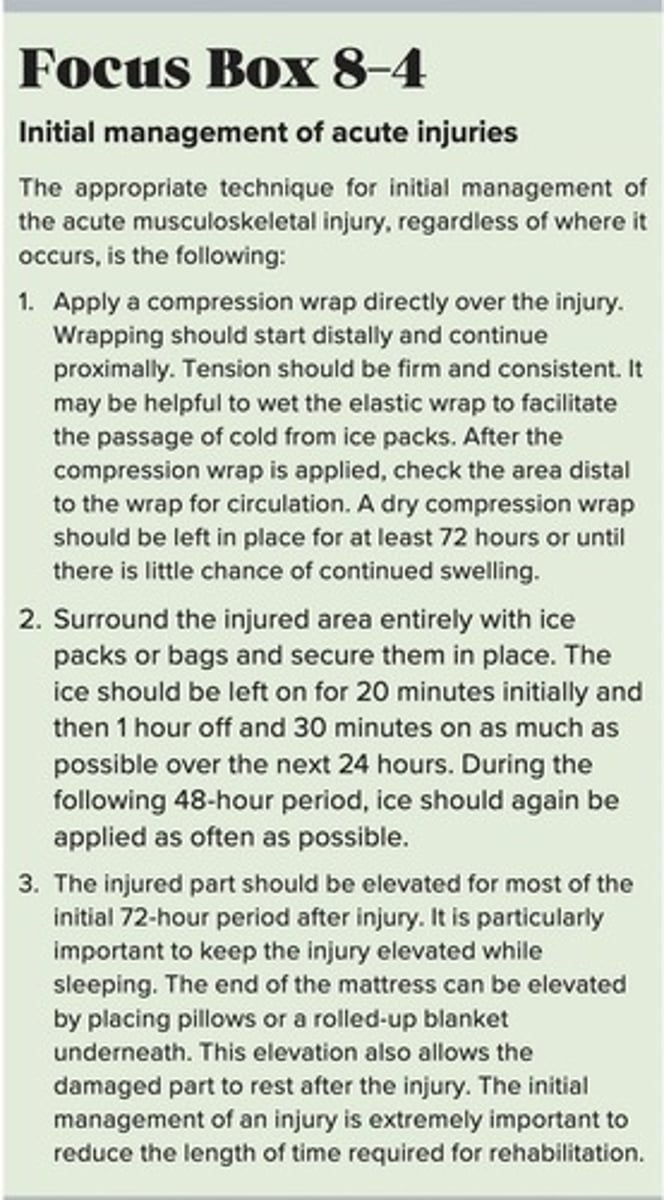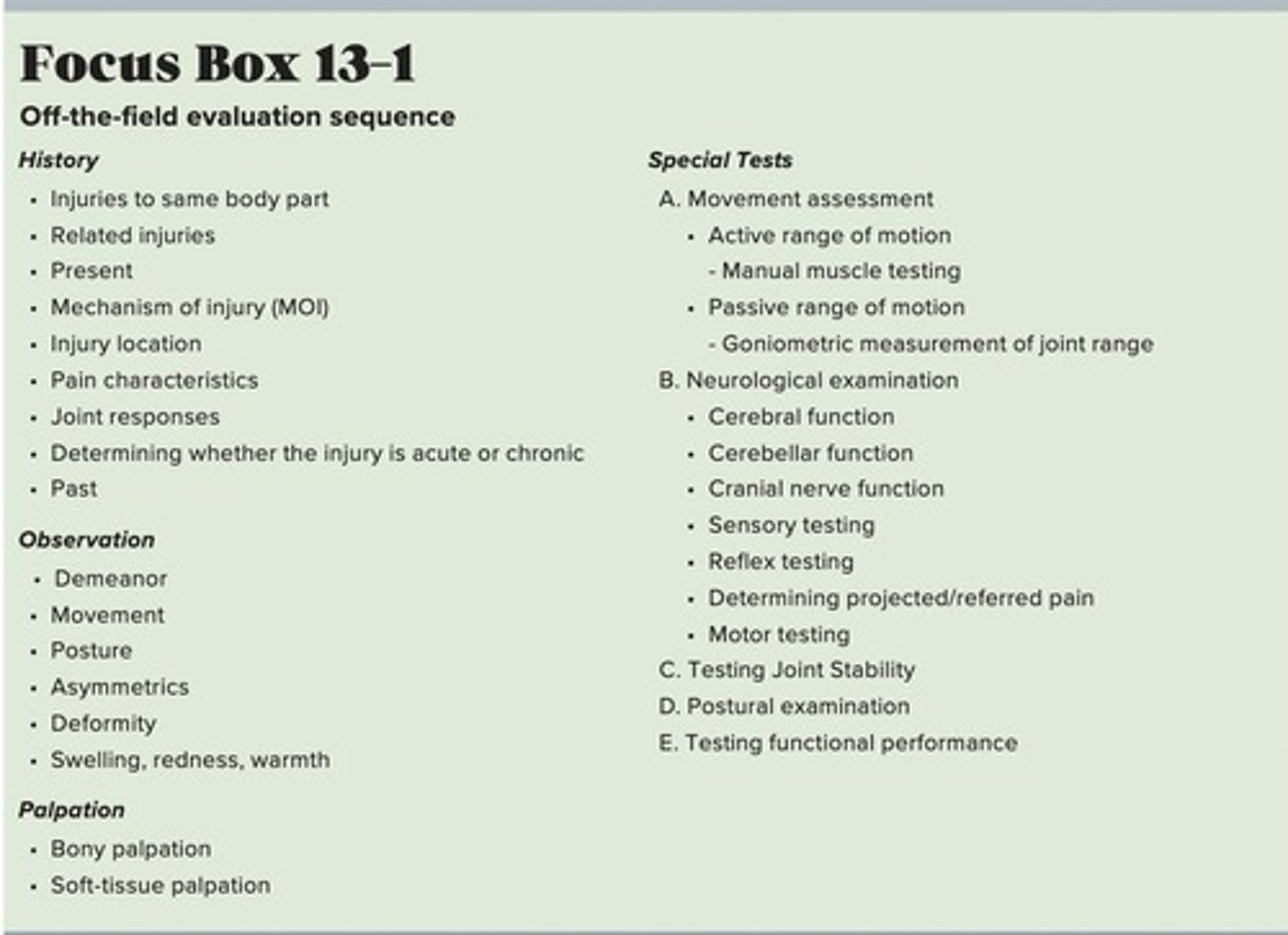Fundamental Concepts in Sports Medicine Evaluation
1/62
There's no tags or description
Looks like no tags are added yet.
Name | Mastery | Learn | Test | Matching | Spaced |
|---|
No study sessions yet.
63 Terms
Injury Evaluation
Essential skill for sports medicine professionals.
Preparticipation Evaluation
Assessment before an athlete starts participation.
On-Field Injury Assessment
Immediate evaluation during athletic activity.
Off-Field Injury Evaluation
Detailed assessment after the activity.
Progress Evaluation
Ongoing assessment of recovery and rehabilitation.
Anatomy Knowledge
Understanding of human body structure for assessment.
Biomechanics
Application of mechanical forces on living organisms.
Mechanism of Injury (MOI)
Cause of injury described mechanically.
Etiology
Cause of an injury or disease.
Pathology
Structural and functional changes from injury.
Symptoms
Subjective changes reported by the patient.
Signs
Objective indicators of a specific condition.
Diagnosis
Identification of a specific medical condition.
Differential Diagnosis
Process of ruling out possible conditions.
Primary Survey
Initial assessment focusing on life-threatening injuries.
Secondary Survey
Detailed information gathering about the injury.
Surface Anatomy
Study of external body landmarks and structures.
Body Planes
Imaginary lines dividing the body for evaluation.
Abdominopelvic Quadrants
Regions of the abdomen for assessment purposes.
Musculoskeletal System
Body system involving muscles and bones.
Standard MSK Terminology
Common terms for describing body positions.
Rehabilitation Design
Creating recovery plans addressing functional aspects.
Activate EAP
Call Emergency Action Plan for severe injuries.
CPR/AED
Cardiopulmonary resuscitation and automated external defibrillator use.
Control Bleeding
Apply pressure to stop blood loss.

Manage Shock
Stabilize patient experiencing shock symptoms.
Vital Signs
Measurements of heart rate, respiration, and blood pressure.

Level of Consciousness
Assessment of a patient's awareness and responsiveness.
On-Field Inspection
Evaluate injury seriousness and transport needs.
Off-Field Evaluation
Assessment using history, observation, and palpation.

HOPS
History, Observation, Palpation, Special Tests framework.
Palpation
Feeling tissues to locate injury specifics.
Neurological Exam
Assessment of nerve function and response.
Joint Stability Testing
Evaluate the integrity of joint structures.
POLICE
Immediate treatment: Protect, Optimal Load, Ice, Compression, Elevation.
Cultural Diversity
Understanding patient's cultural beliefs in evaluation.
SOAP Note
Standard format for documenting injury information.
Progress Evaluations
Monitoring recovery compared to previous assessments.
Special Tests
Movement assessments for injury evaluation.
Goniometric Measurements
Assessing joint range of motion quantitatively.
Functional Performance Testing
Evaluating patient's ability to perform tasks.
Subjective
History taking to elicit personal impressions.
Objective
Visual and physical assessment of injury.
Assessment
Professional judgment regarding injury severity.
Plan
Treatment and referral strategies for injury.
History Taking
Process to gather athlete's personal injury account.
Visual Inspection
Observation of injury for deformity or swelling.
Active Motion
Athlete moves joint without assistance.
Passive Motion
Examiner moves joint without athlete's effort.
Resistive Motion
Athlete resists examiner's force during movement.
Point Tenderness
Specific area of pain upon palpation.
Lachman Test
Assessment for ACL integrity in the knee.
Anterior Drawer Test
Test for anterior stability of the knee.
MMT
Manual Muscle Testing for strength evaluation.
Chronic Treatment Plan
Long-term strategy for ongoing injury management.
Short-Term Goals
Immediate objectives for injury recovery.
Long-Term Goals
Overall recovery objectives over time.
Reevaluation
Follow-up assessment to monitor progress.
Compression Wrap
Bandaging technique to reduce swelling.
Ice Application
Cold treatment to minimize swelling and pain.
Elevation
Raising injured area to reduce swelling.
Non-Weight Bearing
Avoiding pressure on injured limb.
Ankle Sprain
Moderate injury with partial ligament tear.